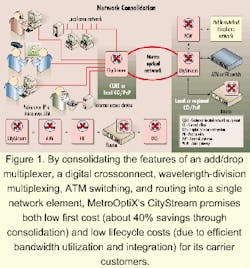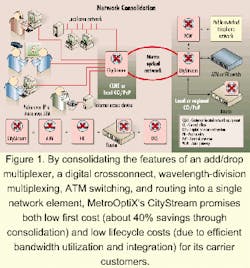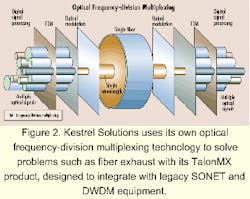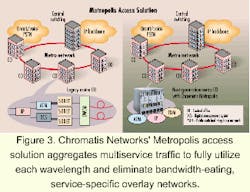So many choices where once there were none
Robert Pease, Senior Editor
Just a few years ago, telecommunications carriers were focused on solving capacity problems in their long-haul backbone fiber-optic networks. Dozens of equipment manufacturers went to work, and the DWDM market soared as the hottest telecom market in recent memory-and several companies made lots of money by bringing the necessary products to market in advance of their competition. Today, carriers can enjoy almost unlimited long-haul capacity with networks capable of scaling to terabit speeds and beyond.But before these carriers could congratulate one another on solving global capacity needs, a bigger problem was taking shape, driven by skyrocketing data traffic as the world embraced the Internet and its limitless possibilities. Business customers, not to mention residential users, realized a need for faster speeds and greater bandwidth-and carriers could only stand by and watch their voice-centric metropolitan networks become obsolete as data-centric traffic grew to unprecedented levels.
Although the problem was great, the opportunity was even greater. Carriers quickly realized that converting to data-centric metropolitan transport would generate huge earnings. But the problems were many, and the solutions were nearly nonexistent. Today, however, it may not be a question of "if" they can convert to data-friendly networks, but which of the dozens of solutions will best fit their particular needs.
Just as with DWDM a few years back, new equipment manufacturers are vying for the attention of carriers in the metropolitan access market, while competing with industry heavies like Ciena Corp. (Linthicum, MD), Lucent Technologies (Murray Hill, NJ), Nortel Networks (Brampton, Ontario), Cisco Systems (San Jose, CA), and others. Recently, metropolitan access solutions have been a highlight of telecommunications conferences, such as SUPERCOMM 2000 just last month. There are as many unique solutions as there are new companies introducing them, and carriers are excited about the prospects of new revenues from the metropolitan space.
Six of the newer metropolitan-access solution companies competing for the carriers' business released products in the last few months. There are many more companies (some will likely pop up before this article goes to print), but these six are representative of a searing hot new marketplace that now offers choice where choice was absent just months ago.
The companies are ONI Systems Corp. (formerly Optical Networks Inc.-San Jose); Metro-OptiX (Santa Clara, CA); Kestrel Solutions (Mountain View, CA); Chromatis Networks (Bethesda, MD); Astral Point Communications Inc. (Chelmsford, MA); and Alidian Networks Inc. (Mountain View, CA). Each offers a solution for the carriers to tap into the growing data business in the network's "last mile." The products they offer address the problems as they see them."Today, the 'metro gap' exists between the high-capacity, long-haul networks and the growing capacity of the local access networks," says Marianne Wu, director of business development at ONI Systems. "Whereas long-haul carriers focus on capacity, carriers in this metropolitan area must focus on service delivery, such as network flexibility, manageability, and service transparency. Issues such as inefficient means of bandwidth scalability, service management, and circuit provisioning are driving the need for next-generation metropolitan networks."
ONI's dynamic transport system (DTS) solution consists of three parts: the ONLINE optical transport platform, OPTX optical-network operating system for wavelength and service management, and OLMP optical-link-management protocol suite for internetworking between the optical transport and data or voice switching layers of the network. "These parts work together to meet four critical network requirements," says Wu. "They achieve low 'first cost' and scalability, universal service-transparent optical interfaces and dynamic wavelength provisioning, efficient optical-layer protection for fast service restoration, and end-to-end optical connectivity management and integration with client equipment."
The ONI platform enables carriers to manage their multivendor networks, currently managed autonomously through individual interfaces and operating systems. Wu believes ONI's next-generation platform will deliver an economically and technologically flexible and reliable optical network. "Through this all-optical transport system, the carrier will be able to provision their customers' circuits dynamically and manage their multivendor connections to provide a single, service-transparent interface for multiple services and rates," adds Wu.
ONI recently announced relationships with several carriers that operate or are building metropolitan networks, including COLT Telecom Group in Europe, KVH in Japan, Marietta FiberNet in Georgia, and MetroRED in Latin America. Trials are currently underway with several other carriers.
One of the newest kids on the access block is Metro-OptiX, a recent optical spinoff of Ericsson (Stockholm). This new entrant believes the problems in the access market confront all the carriers, whether incumbent local-exchange carriers or shiny new emerging carriers. The primary task is still how to utilize bandwidth efficiently-and it doesn't matter whether they have their own physical fiber plant or are leasing fiber from someone else. The fact is, says Mark Milliman, director of product management at Metro-OptiX, whatever fiber they have will eventually become exhausted."The challenge carriers have before them is how to improve the efficiency of their existing plant," says Milliman. "One method is to distribute bandwidth management to the edge of the network. Backhauling metropolitan-area traffic to large digital-crossconnect-system hubs is eliminated and facilities can be better filled on their way to the backbone. Carriers realize that packetizing traffic is another way to improve efficiency, but they are stuck deploying TDM [time-division multiplexing] services. They require service elements that function in today's environment, while allowing them to evolve to newer cell or packet transport."
But bandwidth management will not protect the carrier against the explosive growth predicted for metropolitan bandwidth. Milliman believes DWDM is the answer, even in the access network, for providing additional bandwidth. Along with DWDM, however, comes considerable expense. Carriers who depend on colocation are also faced with the daunting challenge to maximize bandwidth use while differentiating their services, all from a 10x10 cage.
To address these issues, Metro-OptiX introduced its CityStream multilevel-bandwidth manager for metropolitan networks. The product combines the features of an add/drop multiplexer (ADM), digital crossconnect, wavelength-division multiplexer, Asynchronous Transfer Mode (ATM) edge switch, and router into a single network element. CityStream boasts support for up to 288 equivalent DS-3 (44.736-Mbit/sec) and six OC-48 (2.5-Gbit/sec) interfaces in a single 7-ft-bay frame.
"The platform functions in a pure TDM, ATM, or IP [Internet-protocol] environment or any combination thereof," says Milliman. "That enables carriers to manage today's TDM-based services and migrate to a pure IP-over-SONET architecture using ATM in the interim."
Metro-OptiX bases its solution on eliminating the bottlenecks in the access network by integrating multilayer-bandwidth management into a single network element called a multiservice provisioning platform. The company feels the best way to solve carriers' problems is to recognize that they are really packet transport companies, if not now, then soon. Today, they need to manage their TDM bandwidth at the edge of the network and provide ATM- and IP-based services, as well.
"By combining SONET and asynchronous DS-1 and DS-3 bandwidth management such as crossconnecting with packet and cell switching and routing, carriers can efficiently utilize their copper and fiber plant in a single dense network element," says Milliman. "The integral DWDM capability provides for bandwidth growth using existing plants, thereby increasing the value of the plant and improving revenues."
CityStream was announced May 22 and field trials are underway. General availability is planned for the fourth quarter of this year, and Metro-OptiX says they are in serious discussion with several major carriers and competitive local-exchange carriers (CLECs).
Kestrel Solutions sums up the carriers' metropolitan dilemma as the need to cost-effectively get more bandwidth to end users, while the "where and how" is a constantly moving target. Carriers need ultimate flexibility to quickly respond to new service requests without having to pay for the capacity until they need it. That creates a need for a solution with low startup costs and a high degree of modularity that limit the potential for stranding equipment.
With that objective in mind, Kestrel introduced its first product, the TalonMX, to provide up to 10 Gbits/sec of protected capacity in a single bay. Using its patent-pending optical multiplexing technique, based on frequency-division multiplexing (FDM), Kestrel provides operational features like full performance monitoring, remote operations, simple engineering and installation, and robustness over any fiber type, including fiber with high polarization-mode dispersion (PMD).
Optical FDM is a synthesis of three technologies: FDM, digital signal processing, and optical modulation. When combined, carriers are able to provide high capacity and full flexibility at a low cost, while solving problems such as fiber exhaust and integration with legacy SONET and DWDM equipment.
"Optical FDM provides a low-cost solution so carriers can cost-effectively move bandwidth closer to the customer without having to go through the time-consuming and costly proposition of laying more fiber," says Dawn Hogh, vice president of marketing for Kestrel. "The scalability and flexibility of optical FDM also allows customers to start with minimal capacity and then add capacity via a simple circuit-pack addition. Carriers only pay for the capacity they are using."
Kestel's TalonMX was introduced at OFC 2000 in Baltimore last March. Field trials began last month with a major regional Bell operating company (RBOC), and commercial availability is expected this month with customer announcements by third-quarter 2000.
Astral Point's approach for metropolitan access involves the creation of a self-healing mesh architecture, incorporating a patented algorithm that enables SONET-quality protection and restoration capabilities. The architecture promises fast, easy, and cost-effective provisioning for the metropolitan area, while enabling carriers to maximize fiber efficiency by offering different protection classes of service.
The company's ON 5000 optical-services node is a multiservice, multifunctional transmission platform that increases the capacity of existing fiber, provides integration with existing SONET rings, delivers new optical mesh networks, and enables the delivery of multiple services from a single platform.
"Astral Point's overall strategy is to make metropolitan optical access possible for an advanced generation of broadband carrier services," says the company's marketing vice president, Bill Mitchell. "As carriers build brand new network infrastructures to provide such services, our technology approach enables critical capabilities, such as fast provisioning, flexible network scalability, and 'pay-as-you-grow' capacity."
The ON 5000 completed beta testing at Advanced Telecom Group and is already commercially available. The company announced its ONset Network Manage ment System last month at SUPERCOMM 2000.
"With the increased competitiveness between carriers, service providers will lose business unless they offer service breadth, fast provisioning times, and cost-effective services," says Alidian Networks marketing director Ted Rado. "With more and more data connectivity being required, traditional voice-centric SONET equipment, which is the primary equipment found in metro access networks, does not fit these requirements."
With that in mind, Alidian set out to develop its metropolitan access solution. The company conceived a service ADM, rather than a circuit ADM, that combined both access and transport functionality; offered a wide range of data services like IP, ATM, Ethernet, Fibre Channel, and Escon; allowed dynamic end-to-end provisioning of those services; and substantially reduced the cost per bit.
Alidian developed two patented technologies, WavePack and WaveSwitch, to meet the service providers' metropolitan access requirements. WavePack allows multiple protocols and services to share a SONET-framed wavelength. IP, ATM, Ethernet, TDM, and other specialized services are able to share a single optical resource and be carried in their native mode. Without protocol conversions to TDM timeslots or ATM, service breadth and bandwidth efficiency both increase dramatically, says Rado.
Alidian's WaveSwitch matrix allows individual services packed within a single wavelength to be added or dropped at multiple nodes around the infrastructure. The process eliminates the need for digital or optical crossconnects in the metropolitan environment and creates logical mesh topologies.
The OSN 4100 and OSN 4200 are access platforms, scaling from one to four OC-48c (2.4-Gbit/sec) wavelengths. The OSN 4800 is the central-office or point-of-presence (PoP) aggregation platform targeted toward the main hubbing points in the network.
The OSN 4100 and 4200 are available today in production quantities. The OSN 4800 will become available in third-quarter 2000. Alidian announced several field trials for the OSN 4100 and 4200, including Enkido and Everest Broadband, and expects more field trials in the coming quarter.
According to Chromatis, a successful metropolitan transport system must address two issues: efficient aggregation of the increasing volume of multiservice access traffic and the job of squeezing that traffic onto optical transport systems that are already strained.
"To provide their customers with a flexible array of access alternatives, carriers have historically resorted to building separate service-specific overlay networks," says Chromatis product marketing director Lou Martinage. "For instance, to support an ATM service, providers will maintain an equipment layer of ATM switches that ride on top of a transport and crossconnect infrastructure. The result is that the carrier's central office is packed with racks and racks of service-specific equipment. This approach will not scale, as multiservice access demand continues to accelerate."
Maintaining the multiple equipment layers also results in a fragmented management model that complicates service provisioning. With highly trained personnel becoming harder to find and retain, this management model is doomed to failure, as service demands continue to increase. Martinage also points out that with the increase in service demands, the voice-optimized SONET infrastructures are being overwhelmed and optical bandwidth is being constrained.
To enable carriers to resolve these issues, Chromatis introduced its Metro polis platform for flexible, high-density multiservice aggregation. With integrated ATM switching and SONET ADM crossconnect functionality, Metropolis efficiently grooms traffic to fully utilize all wavelengths. Additionally, integrated multiwavelength optical transport capability ensures that the metropolitan network can scale to address future growth in service demand.
"Our strategy for addressing the metro access market incorporates several objectives," says Martinage. "First is to aggregate the full range of multiservice access traffic with a single equipment layer. Next is to maximize the use of valuable optical resources and ensure that the optical transport system can scale to accommodate future growth. Finally, Chromatis believes management needs to be kept simple."
The Metropolis product family includes two carrier-class systems, the 4000 and 2000 series, as well as the MetroView network-management system. The 4000 series is a high-density solution that meets the needs of large central offices and switching PoPs. The 2000 series is more compact for smaller central offices, colocation cages, and multitenant office buildings.
MetroView provides integrated multilayer network management, including system configuration, fault and performance management, and multilayer end-to-end provisioning.
Chromatis announced the Metropolis product suite last March, along with a $25-million contract with its first customer, Cogent Communications. The products have been in customer trials since January and general availability is scheduled for this month.
Faced with so many choices of technology and architecture, the only dilemma facing carriers entering the metropolitan space today seems to be which products will be the best fit for them. Some innovative solutions and, inevitably, some of the startup companies behind them, could face elimination in the race for the access market. Ultimately, the carriers themselves will likely choose the winners.
"This is a gigantic opportunity in a very hot market," says Dr. John M. McQuillan, president of McQuillan Ventures. "There is a strong consensus the OEO [optical-electronic-optical] conversion at the first mile is going to be very important. It is the logical place to start. In this horse race, while rings and SONETs are holding their own, mesh and Ethernet are coming on strong. Ultimately, colors of light will win out."
McQuillan says there are three points of view in optical access. Some believe that SONET is the infrastructure of choice and maybe IP over SONET will be important. Others think Ethernet is at least 10 times better than that. And then there are those who favor transparent optical networking.
"Simplicity is the key objective here, and removing software is critical," says McQuillan. "It almost goes without saying that these generations of technology are entering the marketplace very quickly-one on top of the other. Try to envision the full realization of all these developments in the hands of new companies that really 'get it.' That is what makes this business fun and drives all of us to think a couple moves ahead."



